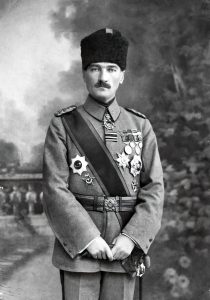21 The emerging Turkish Nationalist Movement by Tamim Azadzoi
Researching the Turkish Republic

Portrait of Kemal Pasha (later known as Atatürk, [father of the Turks]) wearing the Gallipoli Star and Balkan Medal, Author Unknown, Public Domain
| Curriculum context | VCE Modern History Unit 1: Change and Conflict (VCAA, 2020) |
| Historical context | Turkey: Events, ideologies, individuals and movements of the period that led to the end of empires and the emergence of new nation states before and after World War One. |
| Historical thinking concept | Construct historical arguments |
| Learning intentions |
Students will critically study and analyse various perspectives, voices and narratives on the political, social and economic change in Turkey following World War I. |
Activity
You will research and analyse various perspectives on the political, social and economic change in Turkey following World War I, which saw the downfall of the Ottoman Empire. This downfall resulted in a period of social, political and economic change that culminated in territorial loss, and economic ruin. It was within this context where there was a growing nationalist movement spearheaded by Mustafa Kemal Atatürk, that sought to establish the foundation for a modern Turkey to redefine itself away from the memory of the Ottoman Empire, and religious government.
Part 1: Profiling Mustafa Kemal Atatürk
Conduct close research and analysis on Mustafa Kemal Atatürk, to answer the following questions. Discuss with your teacher how this can be presented.
- Who was Mustafa Kemal Atatürk? What role did he play in reshaping Turkish identity?
- What were his main motivations behind the reformation of Turkish government?
- Contextualise the controversy and challenges of the Kemalist movement within Turkey today.
- Present key historiographical perspectives on Mustafa Kemal Atatürk’s leadership. Has this perspective shifted today?
Part 2: Comparing political ideologies
You will undertake this activity in groups of four. Each member of the group is tasked with conducting their own research to analyse available historical sources to present the perspective of ONE of the four factions listed below. Each group member will report back to the group and compare and contrast the differences in ideologies and viewpoints, and take notes of the information that their classmates are presenting to them. Students can refer to the research prompts below a guide to consider the social, political and cultural factors that affected the perspectives of the faction that they choose.
- Turkish Nationalists
- Ottoman Government
- External perspective of a British, French or Italian officer
- Perspective of ethnic minority groups (e.g., Kurds, Armenians, Greeks)
Individually, use your research and analysis to write a short essay on a faction mentioned above that interests you. Focus upon the political, social, and cultural and motivations of the group to justify your motivation and beliefs behind selecting this group. Analyse the lasting impact this faction has had on the rise of modern Turkey, and how might they be represented today. Explain why you might agree or disagree with the ideological principles of the group that you have selected.
Part 3: Historical inquiry
Choose one of the following prompts to investigate as an historical inquiry. Discuss presentation formats with your teacher.
-
Inspect the policies implemented by the Turkish Republic that contributed to reshaping and reformation national Turkish identity. How did these policies aim to create a new sense of cultural identity?
-
Explain how did the fall of the Ottoman Empire contributed to the changing political landscape in Turkey after World War I?
-
Closely analyse the rise of the Turkish National Movement led by Mustafa Kemal Atatürk. What was its ideology? How did this ideology help transform Turkey’s political direction?
-
What was the historical significance of the Treaty of Sèvres and the Treaty of Lausanne? What were the main political consequences of these treaties for Turkey, and establishment of the Turkish Republic?
-
Inspect the interests and the role that major Western powers (British, French, Italian) played in establishing Turkey’s new political identity after the fall of the Ottoman Empire?
-
Examine the effect that the fall of the Ottoman Empire had on Islamic institutions and practices in Turkey after the World War? Was Turkey losing its religious identity?
-
Develop your own research prompt.
References
Kubicek, P. (2023). Introduction: reflections on the centenary of the Republic of Turkey. Turkish Studies, 24(3):407–411, https://doi.org/10.1080/14683849.2023.2210352
VCAA. (2020). VCE Study Design: History 2022-2026. Victorian Curriculum And Assessment Authority. https://www.vcaa.vic.edu.au/curriculum/vce/vce-study-designs/history/Pages/index.aspx

